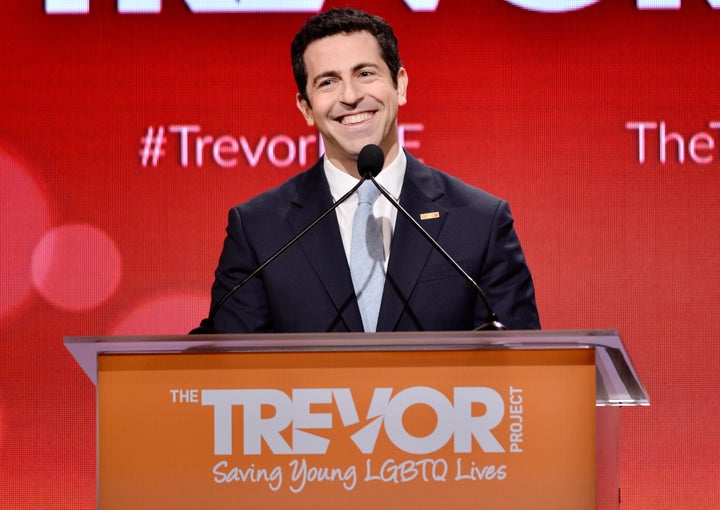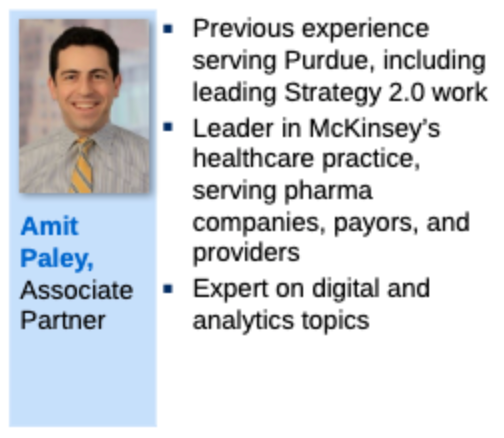
In the summer of 2016, America’s opioid epidemic was raging, and Purdue Pharma, one of the drug manufacturers at the center of the maelstrom, was seeking outside help to manage its collapsing reputation.
For Amit Paley, a rising associate partner at the global consulting giant McKinsey & Co., it was an opportunity. He had worked closely with Purdue before and seemed eager to do so again. So, on a Friday evening in June, Paley scrambled to come up with a list of past examples of how companies selling dangerous products had reduced risk in order to avoid liability and salvaged their reputations with an outraged public.
He suggested looking to pharmaceuticals that carried risky side effects — but also, to consider Twitter, noting it was “lauded for opening discourse but also [a] hotbed of lots of hatred and anonymous vicious attacks,” and trains, saying, “people initially thought they would be very dangerous.”
“Ideally, we would highlight products/services that are positive,” he wrote to another McKinsey consultant, “but carry risks of being abused.”
Today, Paley has a new job: executive director and CEO of the country’s largest LGBTQ crisis hotline, The Trevor Project, which he has led since 2017. The Trevor Project provides thousands of young LGBTQ people every year with crisis and suicide prevention counseling through its national hotline, and it drives research and lobbies for resources dedicated to preventing youth LGBTQ suicide. Under Paley, the organization has overseen the launch of a 24/7 digital crisis service, a six-fold increase in the number of young people it serves, and the start of a global launch outside the United States.
The Trevor Project is also among the countless nonprofits now grappling with the fallout of the opioid crisis: A report the group put out in January said the misuse of prescription drugs was associated with a threefold increase in suicide attempts by LGBTQ people.
Purdue Pharma was dissolved last year in a settlement that set aside $4.5 billion for states suffering the impacts of the opioid crisis.
By the time of Paley’s work with Purdue, the opioid epidemic and its deadly toll were undeniable. Purdue was beginning to attract public notoriety and legal scrutiny, and its aggressive marketing of OxyContin was widely blamed by experts for creating a generation of people addicted to opioids. In 2015, more than 33,000 people in the United States died of an overdose involving an opioid, a number that soared in the years to come. In 2016, a national federal survey found that almost 4 million people in the U.S. were abusing prescription oxycodone.
Besides helping McKinsey compete for Purdue’s crisis response business, Paley collaborated with Purdue executives over a period of four or five weeks on a strategic 10-year plan to boost the sales of opioids and other Purdue products. Later, as McKinsey competed to handle data analysis for Purdue, his team suggested ways to use data to support Purdue’s sales goals and undermine its critics.
“Seven years ago, when I was a consultant at McKinsey, I was assigned to a project for Purdue,” Paley said as part of a statement to HuffPost. “If I knew then what I know now, I would not have agreed to do any consulting for that company, and I regret that I did.”
Paley’s work with Purdue has not been previously reported. Of his seven years working for McKinsey, his biography on The Trevor Project’s website says only that he “served numerous non-profit organizations, Fortune 500 companies, and governments.”
His role came to light thanks to McKinsey’s $573 million settlement with a coalition of 47 state attorneys general over the firm’s role in driving the opioid crisis. For more than a decade, McKinsey provided Purdue with detailed advice on how to maximize sales of its blockbuster opioid, OxyContin. The settlement terms allowed McKinsey to avoid any admission of wrongdoing, but required it to make public more than 100,000 emails, presentations, and other internal documents from the years it spent advising several of the nation’s leading opioid makers.
HuffPost reviewed hundreds of emails, slideshows, agendas and documents that Paley traded with colleagues and clients.
His first assignment was to a project to create a 10-year strategic plan for Purdue, with a goal of helping the company reach $700 million in annual distributions.
“I want him to feel the love from us.”
- Instructions Amit Paley received on how to treat a Purdue Pharma executive
Most of the strategies McKinsey laid out were aimed at protecting Purdue’s share of the opioid market, such as by creating an in-house litigation team to challenge rival opioid makers using intellectual property law, and helping its recently expanded sales force pump more prescriptions into regional health care networks and long-term care facilities. “Protect OxyContin,” “Protect Butrans” and “Protect Hysingla” — the latter two are other Purdue brand-name narcotics — were labeled priorities number one, two and three.
Paley’s role in the 10-year plan project was to be the engagement manager, or the liaison between Purdue executives and the rest of the consulting team. Starting in September 2015, Paley worked with Purdue on an almost daily basis, often taking a car service up to the company’s headquarters in Stamford, Connecticut. He fielded lists of new and ongoing business initiatives from Purdue’s top executives, which the McKinsey team then fleshed out as long-term profitability strategies that they presented to Purdue.
McKinsey places a high value on “client continuity,” and so, after his work on the 10-year plan, Paley hustled to stay involved with Purdue.
He helped McKinsey win the rights to overhaul Purdue’s global procurement process, and he helped assemble a new consulting team when Purdue turned to McKinsey for corporate development advice.
“I want him to feel the love from us,” Laura Moran, a McKinsey partner overseeing the project, told Paley as he was corresponding with Ed Mahony, a Purdue executive vice president.
In May 2016, Paley became a key member of a McKinsey bid to create a big data strategy for Purdue. Paley, because he had experience with Purdue, would have helped lead the data project on a day-to-day basis, according to versions of the proposal dated the day it was submitted to Purdue. A source close to The Trevor Project said it would be inaccurate to describe Paley as a leader of any of McKinsey’s Purdue-related work and noted that his promotion to associate partner was in the pipeline but not yet in effect. “The description of his role is inflated to win the account,” he said.

As part of its pitch, the team proposed a long list of ways that McKinsey’s proprietary analysis capabilities could help Purdue sell more products. One option McKinsey presented was to strategically redeploy salespeople to regions where demand was greatest; another was identifying “undiagnosed patients” who weren’t taking Purdue’s “high-value products” but could be.
McKinsey also pitched using data analysis to shield Purdue from a growing public backlash. The firm had previously helped another pharmaceutical company combat negative impressions on Facebook and Twitter with methods like creating a patient advocacy group, McKinsey said, and could do something similar for Purdue.
Big data could even help discredit negative press, it said in its pitch: Weeks earlier, the Los Angeles Times dropped a damning report on how Purdue had marketed OxyContin as offering 12 hours of pain relief despite knowing that the effects often wore off sooner — “the perfect recipe for addiction,” in the words of a leading researcher. The story relied partly on research performed by Purdue itself. McKinsey nevertheless claimed it could produce data to counter the Times’ “anecdotal” reporting.
“Fingers crossed that we win this!” Paley wrote to his team members as they prepared to submit the proposal. Purdue ultimately awarded the contract to a rival firm.
In June 2016, Paley helped McKinsey compete for a slice of Purdue Pharma’s crisis management business. That was when he drew up the list of other hazardous consumer products. Purdue did not carry out McKinsey’s recommendations, a spokesman for McKinsey said.
“Fingers crossed that we win this!”
- Paley, as his team competed for new Purdue business
“Amit served Purdue for a relatively brief period of time while in a junior role,” Greg Romano, the spokesman, wrote in reply to questions for this story. “It would be incorrect to present his client service to Purdue as central or leading.”
As for Paley coming up with a list of high-risk products that could serve as an example to Purdue, Romano said: “That work was not to understand how to avoid liability or improve public reputations. … Rather, it looked at ways in which the company could change its business model to better address the risks of opioid misuse.”
In an email with McKinsey colleagues, Paley described the job as a “competitive proposal related to crisis response.” And in a response to a colleague who asked if Purdue was trying to “improve impressions of opioids” or address risk by taking the lead of other companies that had faced tort liability, Paley replied, “both.”
The source close to The Trevor Project stressed that Paley worked on just one project out of dozens that McKinsey handled for Purdue and billed only 168 hours. He was not in a senior role while working on the 10-year plan or while crafting subsequent proposals, this person said, and was “at most [in] a mid-level position.”
“The Trevor Project CEO search was a thorough and robust process which resulted in hiring the most qualified candidate in Amit Paley,” Gina Muñoz, the chair of the board of directors, said in a statement. “The Board of Directors remains steadfast in our choice of CEO and we are proud of the transformational growth and expansion of life-saving programming at The Trevor Project that Amit has led since the start of his tenure.”
“We have full confidence in Amit as CEO of The Trevor Project and stand firmly behind him,” she continued.
Paley’s team leaders at McKinsey seemed acutely aware that their work could be reputationally toxic. In May 2017, Moran, his supervisor on several projects, told another consultant, Arnab Ghatak, that she planned to give Purdue print copies of a presentation rather than a digital version. “These guys will be deposed,” she reasoned. “Best our emails are not sucked into it.”
Ghatak and Martin Elling, also Paley’s onetime supervisors, were both fired from McKinsey after a 2019 lawsuit brought by Massachusetts Attorney General Maura Healey revealed that the two had discussed destroying all documents related to Purdue. Moran and Elling did not reply to a request for comment, and Ghatak could not be reached.
But if members of the team had personal misgivings about their work for a company at the heart of the opioid epidemic, they did not readily discuss it. On Nov. 9, 2015, Paley and the rest of his team received an email from a McKinsey analyst about a New York Times opinion piece, “How Doctors Helped Drive The Addiction Crisis.” The article laid out how opioids were driving up American mortality rates.
“Worth a quick read,” the analyst said. There is no record of anyone responding.
Paley left McKinsey to lead The Trevor Project in July 2017. He had volunteered for The Trevor Lifeline for six years.
“I left McKinsey to become CEO of The Trevor Project so I could devote all of my time, energy and expertise to scaling this organization’s life-saving work,” he said in his statement to HuffPost. “I am proud of my impact at The Trevor Project over the past five years and I will continue dedicating my life to supporting and saving lives of LGBTQ young people around the world.”
When he left the firm, he had glowing words about his time there. “I am so grateful for all the friends and mentors I have made at McKinsey,” he wrote in a farewell message posted to the firm’s Facebook page. “You are the most inspiring, talented group of people I have ever met.”
